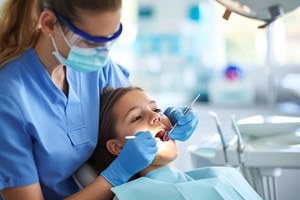Risk factors during first year of life for early childhood caries
Published: 01/10/2013
Leong PM, Gussy MG, Barrow SY, de Silva-Sanigorski A, Waters E (2013) A systematic review of risk factors during first year of life for early childhood caries. Int J Paed Dent23(4): 235-50
Early childhood caries describes dental caries affecting children 71 months of age or younger. The prevalence of decay in children of this age is relatively high, ranging 28–82% depending on the population studied. Despite this the care-index (or proportion of teeth restored) is very low, perhaps not surprisingly largely as a result of the behavioural management issues surrounding this age group.
The risks of untreated early childhood caries include pain, poor sleeping habits, altered eating habits and failure to thrive; therefore, many of these children end up being treated under general anaesthetic, which does not come without its risks. Targeted preventative care is therefore critical. However, in order to provide effective prevention advice it is important to fully understand how the risk factors interrelate and why some children suffer a greater burden of disease than others. The authors of this month's research summary suggest that this is an area where key information is lacking, particularly in relation to the infant's oral environment prior to, and during, early tooth eruption. This research summary describes a systematic literature review of early childhood caries during the first year of life. The authors ask the overall research question ‘What factors occurring during an infant's first year of life influence the initiation and progression of early childhood caries?’
sec-type="methods">Method
Two independent searches of electronic databases were undertaken to capture as many papers as possible. The first explored the acquisition and colonisation of bacteria in children during the first year of life and subsequent development of early childhood caries. The second explored the risk and /or protective factors for early childhood caries in children up to 12 months. Strict quality appraisal and inclusion criteria for identified papers were applied.
sec-type="results">Results
The first search addressing the acquisition of cariogenic bacteria identified a total of 66 papers for review by title and abstract. 62 of these were excluded. The main reasons for exclusion were because the papers did not report on children aged 12 months or younger or because they did not report on studies (e.g. the paper was a guideline or report rather than a study). Four papers therefore remained for quality appraisal and data extraction. The studies all differed in design and methods used to collect, assess and report data; this influenced the ability to assess the consistency of findings across the studies and to make strong conclusions. Methods used by the individual studies to identify and enumerate colony-forming units (or bacteria) varied from direct visual techniques to microscopy (or colony counters). Studies also varied from reporting early lesions to recording frank cavitations only.
The results of the four studies summarised as; three studies detected cariogenic bacteria in infants before their first birthday while the other did not detect Streptococcus mutans (cariogenic bacteria) until the infants were aged 1.5–5 years. All four studies reported finding caries in children during the study period, and in every child with diagnosed caries, cariogenic bacteria were present. However, not all children harbouring these bacteria developed caries during the study period. In addition to this the four studies demonstrated a relationship between the acquisition and levels of cariogenic bacteria in an infant and several mediating factors. The most significant factors identified as resulting in higher levels of bacteria included: habitual kissing on the lips; sharing eating utensils; exposure to dietary sugars more than four times per day; sweetened beverages in bottles; spending more than 10 hours in child care facilities each week and an infant not having their teeth brushed twice a day. Maternal influences increasing the level of infant cariogenic bacteria included: family income; maternal education; and the presence of periodontal pocketing and high S. mutans levels in the mother.

Close-up of the mouth in a young male patient showing a swelling associated with the grossly caries primary dentition
For the search addressing the proposed determinants of early childhood caries a total of 313 papers were reviewed. After quality appraisal, 10 papers remained. The main factors identified as appearing to increase an infant's risk of early bacterial acquisition and higher levels of colonisation were maternal factors, such as low level of education, poor oral health knowledge, milk intake during pregnancy and the first year post-natally. Infant feeding practices were also identified as being associated with early childhood caries and this included night feeding, testing and sharing food and the frequency and types of food and liquid introduced. Oral hygiene practices, in particular brushing infant's teeth, were another identified factor. Interestingly, one study in the south of England reported 90% of infants had commenced toothbrushing by 12 months of age and that despite the presence of plaque and intake of non-milk extrinsic sugar, all children remained caries free.
sec-type="discussion">Discussion
The findings of this systematic literature review emphasise the importance of implementing good preventative care early in life and during pregnancy. It would appear that early intervention has the possibility to reduce the prevalence of early childhood caries.
I doubt there are many of us who discuss prevention advice with expectant mothers attending our practice but perhaps this would be a simple place to start. Not only is treatment free for this patient group and, hence, attendance rates high, but also mothers may be more able to take in the important information without the added tiredness and stress that a new child may bring. Additionally, it is important that health visitors and GPs are included in strategies to improve the oral health of this age group, because these members of the healthcare team normally see young children long before we do.
This research reemphasises the effectiveness of dietary preventative care but also makes interesting recommendations with respect to the transfer of cariogenic bacteria from mother to child. Although the authors suggest that mothers with high levels of cariogenic bacteria should be identified in the prenatal period and have their bacterial levels reduced prior to infant tooth eruption, they acknowledge that further exploration is required to fully understand the complex nature of early childhood caries.
Author: MA Healthcare
Please sign in or subscribe to continue reading.
The following article is restricted for Dental Nursing subscribers only. Please sign in to access the full article.
If you have any queries or require more information, Dental Nursing’s friendly customer services team is on hand to help. Call 01722 716997 or email subscriptions@markallengroup.com.
Subscribe to Dental Nursing below and get access to this article. Subscribing will enable you to:
- Update your knowledge in important areas of practice.
- Keep fully up-to-date with the latest developments taking place in clinical practice as they affect you.
- Access restricted content and our CPD platform.








.jpg?width=150&height=100&scale=canvas)




